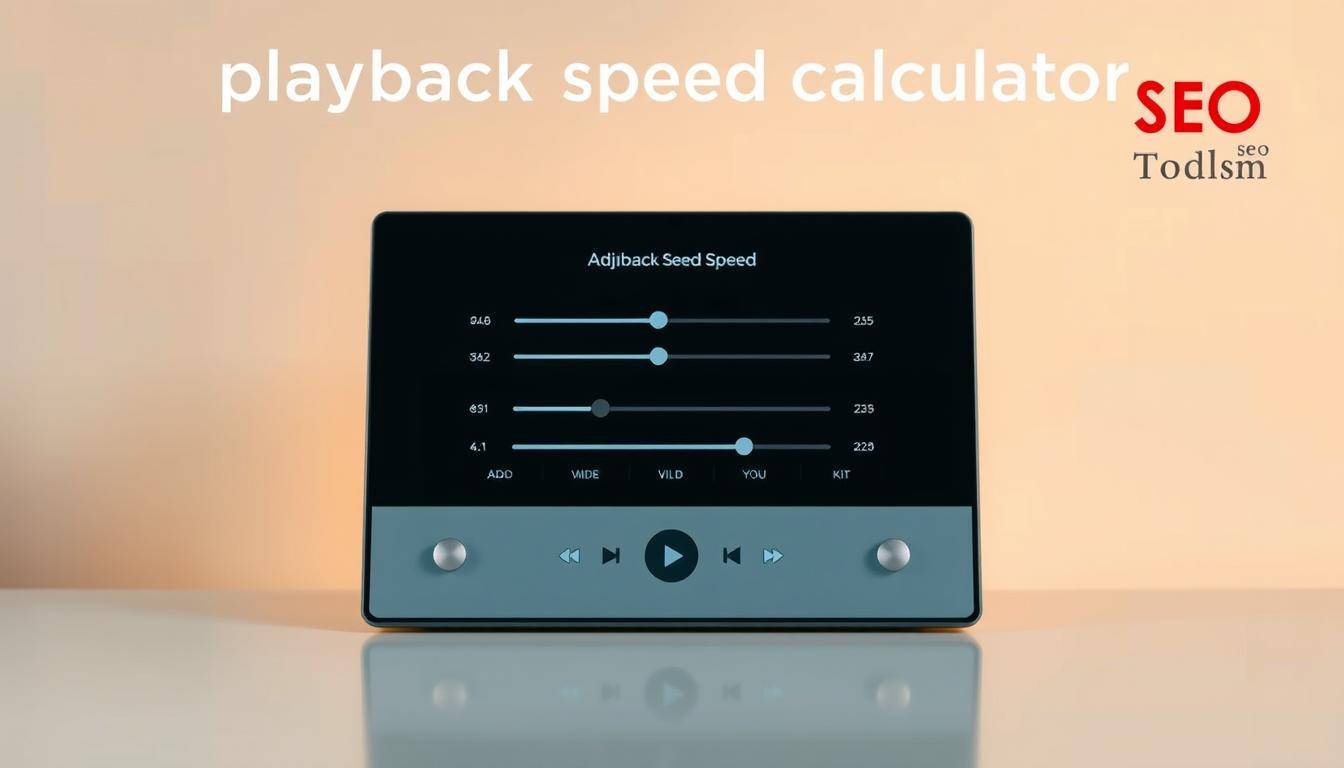Advanced Playback Speed Calculator
Optimize your video and audio consumption with this speed to duration converter. Calculate time saved, required speed, and more.
Video & Audio Playback Time Calculator
Playback Speed Calculator: Determine Your Speed with Ease

Did you know that changing playback pace can cut an hour-long lecture down to just 40 minutes with a 1.5x rate? That kind of time savings reshapes how we plan busy days.
We built a simple tool that converts original duration into an adjusted time using the proven formulas: adjusted time = original duration ÷ chosen rate, and time saved = original duration − adjusted time.
Enter hours, minutes, and seconds, pick any rate from 0.5x to 3x, and our calculator returns results in hh:mm:ss. We give clear time saved, so you can schedule listening or viewing sessions without guesswork.
Designed for creators, students, and professionals, this tool stays fast and reliable. We prioritize accuracy across audio, video, and mixed content so you can try different settings and pick what fits your day.
Key Takeaways
- Our playback speed calculator converts duration into adjusted time and shows time saved.
- Input hh:mm:ss and choose a rate between 0.5x and 3x for instant results.
- Results appear in familiar hh:mm:ss format for easy scheduling.
- We support precise planning for listening and viewing tasks.
- Accuracy and responsiveness help you test multiple options quickly.
Optimize your time with our playback speed calculator tool
Our tool turns hours and minutes into a clear plan so you can reclaim more of your day. Enter hours, minutes, and seconds, then pick a rate between 0.5x and 3x. As soon as you type values, we show the adjusted duration and the time saved.
Results appear in hh:mm:ss, making it simple to slot listening or viewing into your schedule. The interface accepts precise numeric entries so you can test different settings quickly. This helps whether you plan an audio study session, review dash cam footage, or trim long video recordings.
- Instant calculation with clear output in hh:mm:ss.
- Fields for hours, minutes, seconds and selection from 0.5x–3x.
- Compare options side by side to find how much time you save.
| Original duration | Rate | Adjusted time (hh:mm:ss) | Time saved |
|---|---|---|---|
| 01:30:00 | 1.5x | 01:00:00 | 00:30:00 |
| 02:00:00 | 2x | 01:00:00 | 01:00:00 |
| 00:45:00 | 0.75x | 01:00:00 | 00:15:00 (added) |
How to use our tool to calculate adjusted time and time saved

Begin with the exact hours, minutes, and seconds of your content to get a precise result fast. We guide you through three quick steps so you see the adjusted duration and the exact time saved without manual math.
Enter content length in hours, minutes, and seconds
Type the original length in hh:mm:ss. We convert your hours and minutes into total seconds for an exact base value.
Set your desired playback speed (from 0.5x to 3x)
Select any rate between 0.5x and 3x to test faster or slower options. The chosen rate divides the total seconds to produce an adjusted duration.
View calculated duration and time saved instantly
We return results in hh:mm:ss as soon as you enter values. The formula we use is:
Total adjusted time (seconds) = [(Hours × 3600) + (Minutes × 60) + Seconds] ÷ chosen rate.
Time saved equals the original duration minus the adjusted duration. That clear output helps you decide how much time save you gain for audio, video, lectures, or meetings.
- Input original length for precise calculation.
- Choose the desired playback speed between 0.5x and 3x.
- See adjusted duration and time saved instantly in hh:mm:ss.
- Test different settings quickly to match your schedule and attention needs.
Playback Speed Calculator features designed for accuracy and ease
Fast data fields guide you from original length to precise adjusted time without extra steps.
We provide clearly marked inputs for hours, minutes, seconds, and a selectable range from 0.5x to 3x. Typing values triggers an automatic calculation so results appear as you work.
User-friendly inputs for hours, minutes, seconds, and speed
Each field is labeled to reduce errors and make entry consistent across audio, video, and mixed content.
Automatic calculation with immediate results
We divide the total seconds by the chosen rate and return adjusted duration instantly. This gives quick feedback without extra clicks.
Readable output in hh:mm:ss for clear planning
Results display in hh:mm:ss for both adjusted duration and time saved, removing ambiguity when you schedule tasks.
Clean, accessible interface for fast workflows
The layout supports keyboard input and rapid scenario testing so teams and individuals can compare options quickly.
| Feature | What it does | Benefit |
|---|---|---|
| Dedicated inputs | Hours, minutes, seconds, rate selector | Accurate, consistent data entry |
| Instant calculation | Auto-run as you type | Immediate adjusted time and quick comparisons |
| Clear results | Output in hh:mm:ss plus time saved | Simplified scheduling and planning |
| Accessible UI | Keyboard-friendly, minimal design | Speeds repetitive tasks and supports workflows |
How the calculation works: from original length to adjusted playback time

Follow a clear calculation to turn your original hours and minutes into an exact adjusted duration. We keep the math simple so you can compare options and plan listening or viewing sessions with confidence.
Total time formula: convert to seconds and divide by speed
Total time in seconds = [(Hours × 3600) + (Minutes × 60) + Seconds] ÷ playback speed.
Example: a 10-hour listening session at 1.5 speed becomes roughly 6.67 hours — about 6 hours 40 minutes. That adjusted duration is what you schedule into your day.
Time saved formula: original duration minus adjusted duration
Time saved = Original duration − Adjusted duration.
Using the 10-hour example, time saved ≈ 10 − 6.67 = 3.33 hours (about 3 hours 20 minutes).
- Another example: 1.5 hours at 2x becomes 45 minutes, saving 45 minutes from the original 90 minutes.
- We convert length to seconds first, so the calculation works for any content and any lengths.
- Changing chosen speeds gives a linear change in adjusted time, so results stay predictable.
Total adjusted time (seconds) = [(Hours × 3600) + (Minutes × 60) + Seconds] ÷ chosen speed.
Real-world uses: audiobooks, videos, podcasts, and more
Knowing how long content will take at a new rate helps you plan study blocks and work sessions with confidence.
Audiobooks and listening: finish titles faster without guesswork
We apply the same formula to books: total listening time = length ÷ chosen rate. For example, a 10-hour audiobook at 1.5x becomes about 6h 40m, saving roughly 3h 20m.
Video viewing and dash cams: estimate review time and time saved
Convert the full duration to seconds, divide by the rate, and convert back to hh:mm:ss. Examples: 01:20:00 at 2.0 → 00:40:00; 02:15:00 at 1.75 → 01:17:09.
Podcasts, lectures, and meetings: schedule smarter with precise durations
We show how 00:12:30 at 1.5 → 00:08:20 and 00:30:00 at 0.5 → 01:00:00. Use these results to block calendar slots and align team timing.
- Audio and podcasts estimates help you finish more titles in less hours.
- Video workflows make dash cam review and archiving predictable.
- Our tool and speed calculator integrate these examples so you can set a realistic schedule.
Examples at common playback speeds to guide your choices

We show clear examples so you can judge how rates change total time and comprehension. Below are short cases for common lengths and common settings.
1.5x speed example: how much time you save on typical lengths
A 10:00:00 session at 1.5 speed becomes about 06:40:00, giving a time saved of 3 hours 20 minutes.
Short clips shrink too: 00:12:30 at 1.5 speed ≈ 00:08:20. These examples show how much time you reclaim with a modest boost.
2x speed example: halving viewing time with simple math
Doubling playback halves duration. An 01:20:00 video at 2x becomes 00:40:00. The calculation is straightforward and easy to trust.
Use the formula below to replicate results:
Total seconds = (H×3600 + M×60 + S) ÷ chosen speed; time saved = original − adjusted.
Slower speeds (0.5x–0.75x): when careful comprehension matters
Slower rates lengthen duration for detail work. For example, 00:30:00 at 0.5x becomes 01:00:00.
Try different speeds in our calculator to weigh focus against time save for courses, meetings, and edits.
| Original duration | Rate | Adjusted time | Time saved |
|---|---|---|---|
| 10:00:00 | 1.5x | 06:40:00 | 03:20:00 |
| 01:20:00 | 2x | 00:40:00 | 00:40:00 |
| 00:12:30 | 1.5x | 00:08:20 | 00:04:10 |
| 00:30:00 | 0.5x | 01:00:00 | −00:30:00 (added) |
Plan your schedule and balance speed with comprehension

Fit videos and audio into focused sessions by matching duration to your daily flow.
We recommend turning the calculated duration into calendar blocks. Allocate precise start and end times down to the minutes so items slot neatly into your day.
Create viewing and listening blocks using calculated durations
Make recurring slots for lectures, podcasts, or training so your week stays predictable. Use short blocks for heavy topics and longer blocks for review.
Find your desired playback speed without sacrificing understanding
Most people adapt well between 1.25x and 2x while keeping good comprehension. Increase rates gradually in 0.25x steps until you reach a comfortable desired playback.
- Match task complexity: use moderate rates for dense content and higher rates for familiar material.
- Modern time-stretching: preserves pitch, so higher rates work for note-taking and focus.
- Test and train: try similar content types across a week to find a reliable baseline.
| Task | Suggested approach | Example |
|---|---|---|
| New lecture | Moderate rate, short blocks | 60 min → two 30-minute focused sessions |
| Review session | Higher rate, single block | 90 min → 1.5x → 60 min |
| Podcast listening | Gradual increases, recurring slot | 30 min weekly → try 1.25x then 1.5x |
Conclusion
A few quick calculations can convert content length into reliable, schedule-ready durations. Use the core formulas—adjusted time = [(H×3600)+(M×60)+S] ÷ playback speed and time saved = original − adjusted—to plan audio and video work without guesswork.
Our playback speed calculator and related speed calculator examples make it simple to compare alternatives. For instance, 1.5 hours at 2x becomes 45 minutes; 10 hours at 1.5x becomes about 6:40:00.
Try different rates to see how much time saved they give across short clips and long series. Small increases add up over a week, and the calculator returns clear hh:mm:ss durations ready for your calendar.
Apply this method to your current projects and revisit preferred speeds as you grow more comfortable. Simple math plus a focused tool keeps duration under control and improves planning outcomes.
FAQ
What does this tool do?
We calculate adjusted playback time and the amount of time you save when you change the playback rate for audio or video. Enter hours, minutes, and seconds, pick a playback multiplier between 0.5x and 3x, and we show the new duration in hh:mm:ss along with the time saved.
How do we enter the original length?
We recommend typing the full runtime using the hours, minutes, and seconds fields. Our inputs accept zero values for any unit, so you can add just minutes and seconds for short clips or full hours for long lectures and audiobooks.
What range of multipliers can we use?
We support rates from 0.5x up to 3x. That lets us slow content for careful listening or speed it up to save time. The interface prevents entries outside that range to keep results reliable.
How is the adjusted duration calculated?
We convert the original length into total seconds and divide by the chosen multiplier. The result is converted back to hours, minutes, and seconds so you can plan viewing or listening blocks easily.
How do we compute time saved? playback speed Calculator
Time saved equals the original duration minus the adjusted duration. We present that value in hh:mm:ss so it’s simple to see practical savings for schedules or study plans.
Will increasing the multiplier hurt comprehension?
Comprehension varies by person and content complexity. We suggest testing incremental rates—like 1.25x then 1.5x—to find a balance. For dense lectures or technical audiobooks, slower rates (0.75x–1x) often work better.
Can we use this for podcasts and audiobooks?
Yes. We designed the tool for audiobooks, podcasts, lectures, meetings, and videos. It’s especially helpful for planning how many episodes or chapters you can finish in a set time.
Are results instant?
Yes. The calculation updates immediately when you change length or multiplier. That gives instant feedback so we can try different speeds and see effects on duration and savings right away.
In what format are outputs shown?
Outputs appear in hh:mm:ss format for both the adjusted duration and the time saved. This makes it easy to add results to calendars or time-blocking tools without extra conversion.
Do we support nonstandard lengths like dash cam footage?
Absolutely. Any content with a measurable runtime works. We often use the tool to estimate review time for dash cams, security footage, training videos, and long webinar archives.
How accurate is the tool?
The math is straightforward: total seconds divided by the multiplier and proper conversion back to hours, minutes, and seconds. That ensures precise planning for work, study, or leisure.
Can we plan a daily schedule using these results?
Yes. Use the adjusted durations to build focused listening or viewing blocks. We recommend factoring in short breaks and comprehension checks when scheduling longF sessions.
What are common examples of time saved?
At 1.5x, we typically save about one-third of the runtime; at 2x, we halve it. Try the tool with your typical episode or lecture length to see exact savings for your content.
Do you recommend specific rates for different content?
For narrative audiobooks and casual podcasts, 1.25x–1.5x often works well. For technical lectures, aim for 0.75x–1x to preserve comprehension. We encourage experimentation to find what fits your listening habits.
For More Tools: Click Here